

EnableRowAutoSize will turn on row auto sizing for all rows. Its arguments are the property names that need word wrapped enabled. If you need word wrapping, use the –EnableWordWrap parameter.


The arguments are positional starting with the first column. You can also specify the column width with the –ColumnWidth parameter. If there are specific columns that you want listed first, place them in order with –ColumnOrder. The –Data parameter contains the objects that you want to display. When using the Set-DGV function, you need to tell which DataGridView control you want to populate with the –DVG parameter. I used Select-Object to remove the properties that I did not want to display. ColumnWidth 100, 100, 150, 200, 50, 50, 50 `įirst I save the objects that I want into the variable $Info. ColumnOrder Name, Gateway, FullDuplex ` MediaType, MediaConnectionState, FullDuplex, LastErrorCode, Speed $Info = Get-NetAdapter | Select-Object -Property Name, DNSSuffix, IPAddresses, SubnetMasks, Gateway, DNSServers, MACAddress, Status , I created this one to help me with word wrap and to control the order in which the columns appear. I have my own ways of doing things at times and when what is provided does not do everything that I want, I code it myself. ConvertTo-DataGridView helps you format the data. Load-DataGridView helps you load a grid view. For example, when you add a DataGridView, Load-DataGridView and ConvertTo-DataGridView is added to your code. One of the neat things about Sapien’s PowerShell Studio is that when you add a control, you also get some neat functions added to your code to help you populate and use the control. Today I thought that I would share one of my personal helper functions.


 0 kommentar(er)
0 kommentar(er)
